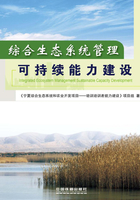
Foreword
Ningxia Province,located in northwest of China,is a vital area under China's One Belt And One Road(OBAOR)policy,and is therefore essential for harmonious economic and ecological development.Asian Development Bank(ADB)and Ningxia Autonomous Regional People's Government cooperated to develop Ningxia Integrated Ecosystem Management Project(IEM),which is an integrated ecological project that aims to control land degradation,improve ecological environment,conduct biodiversity conservation,increase biomass and reduce poverty.
To achieve the above objectives,funded by Global Environment Facility(GEF),Training of Trainers(ToT)Project of Integrated Ecosystem Management(Ningxia)was developed.This project,based on the concept of IEM and multiply considerations on integrated ecological environment factors,develops an inspirited approach to controlling land degradation by involving ecological authorities and stakeholders to natural resource management planning and implementing process,as well as optimizing resources and capital allocation and innovation mechanism.
The Farmer Field Schools (FFS)method was applied during the project implementation,covering the area of agricultural production,wetland management,irrigation,land use,livestock and vineyard management.The project has obtained expected output and outcome,and a Knowledge Product on IEM was produced.It has been proved by fact that ToT is an efficient method for capacity building and project management.The institutional capacity of this project has been strengthened to ensure the sustainability of project implementation.
It is hoped that the project outcome would be further disseminated,and contribute to China's strategic policy on OBAOR and Building Socialist Ecological Civilization,finally achieve the sustainable ecological and economic development.